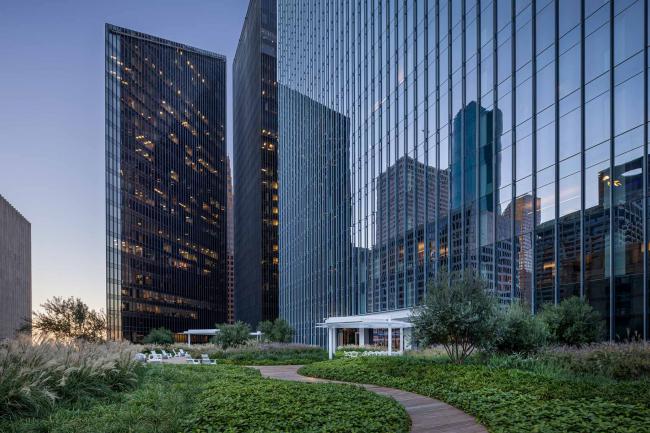In 2017, the city of Houston faced catastrophic flooding after Hurricane Harvey and resources such as food and drinking water are often stretched thin after a natural disaster. Today, the city is striving towards a disaster-resilient infrastructure.
The new Bank of America Tower is the latest move in this direction. Water that arrives into the building is conserved and resued in ingenious and resourceful ways.
From Green Roof to Reclaimed Water Flushometers
On the 12th-floor roof of the 35-story building, is a green roof that functions as a 24,000-square-foot sky park for tenants. With hardwood planks and indigenous plants in this sky park, the environment is very similar to the natural space that lines Houston’s Buffalo Bayou.
The green roof collects all the rainwater that falls on it which also helps cool the building. Furthermore, the collected rainwater is then used to nourish the indoor plants—or it may have an even more important job improving water conservation in the building’s restrooms, by being recycled and reused into reclaimed water that’s great for flushing toilets and urinals.
If so, the rainwater will be circulated into one of the Sloan Royal® 111 RW flushometers specified on all toilets and urinals throughout the building. These flushometers are specially designed to withstand the higher chemical concentrations of non-potable water. By helping flush a toilet or urinal, rainwater helps reduce the facility’s water bills by almost 80 percent.
Rainwater collection also help Bank of America Tower maintain its status as Houston’s most sustainable building.
Houston’s Most Sustainable Building
Given Sloan’s commitment to sustainable commercial design, it’s no surprise that our products were specified for all the restrooms in Bank of America Tower. The building, opened in June 2019, is not just a LEED platinum building—it was one of just three U.S. facilities that served as a benchmark for the new LEED v4 standards.
Beside its remarkable stormwater capture, recirculation, and water-saving capabilities, the facility boasts several more leading-edge sustainability features:
- To cool the interior more efficiently during Houston’s scorching summers, its floor-to-ceiling windows are equipped with low solar heat-gain coefficient glass.
- The building’s elevators harness regenerative energy to save electricity.
- An energy recovery wheel pre-cools fresh air before it enters the mechanical system, saving energy and cooling costs.
- CO2 sensors reduce energy waste by regulating the amount of fresh air the building needs to keep workers focused and alert.
- Daylight dimming controls automatically adjust lighting based on available sunlight to lower electricity demand and reduce thermal load.
Full Transparency with Environmental Product Declarations
The Sloan Reclaimed Water Flushometers specified for the Bank of America Tower don’t just save water. They’re also prime examples of transparency regarding their environmental impact.
These flushometers, like many Sloan products, come with Environmental Product Declarations (EPDs) that document exactly how much their composition impacts the environment across their lifecycle, from material sourcing through final disposal.
That’s the level of transparency you’d expect from Houston’s most sustainable building.
Sloan technology has contributed to the construction and renovation of many of the world’s most advanced office buildings. Want ideas for making your next commercial restroom design more stylish and water-efficient? Talk to Sloan!
Stay Up to Date
Sign up for the Sloan blog to receive information on the latest trends in commercial building, technology advancements and product updates. It's the leading source of industry news for architects, designers, engineers and contractors.
